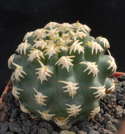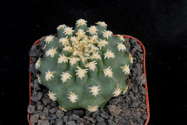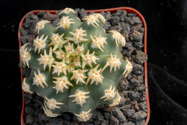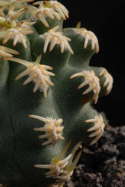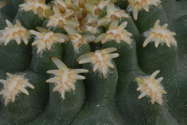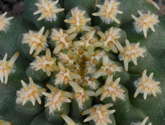At first glance this choice miniature cactus could be mistaken for a form of Pediocactus peeblesianus, that much sought-after but difficult to grow species from the four corners region of the southwest US. This Pygmaeocereus, however, is a South American look-alike, considerably easier to grow on its own roots. It is rather different than the only other species in the genus, P. bylesianus, with its short, thick spines, resembling miniature grains of rice, in charming clusters lining the ribs. The stems are also more globular than those of P. bylesianus. Some authors recognize a compact spiny form of P. bylesianus as P. familiaris and Lodé in his new Taxonomy of the Cactaceae has chosen to combine these species under Haageocereus based on floral similarities (trumpet shaped, nocturnal and fragrant). However, he acknowledges their matte, reticulate seeds, distinct from the smooth, shiny ones typical of Haageocereus and retains Pygmaeocereus as a subgenus. P. biebelii was described in 1995 but is still not nearly as widely cultivated as such a gem deserves. The species is reported from ca. 100 km NW of Haraz, on the W side of the Cordillera Blanca, Dept. Ancash, Peru. We offer seedlings, HBG 125916, $10.

Published in the Cactus and Succulent Journal, Vol. 88 (3), May-June, 2016
